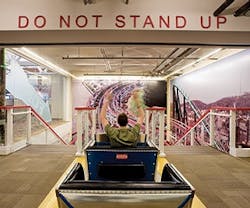The New Normal: The Results-Oriented Office
A strict all-work-and-no-play policy is the norm for most offices, but like everything else in our rapidly evolving world, that is starting to change. As the workday continues to stretch beyond the traditional punch-out time, the line between work life and private life gets fuzzier every day—and that’s not always a bad thing.
Americans are accustomed to putting in long hours at the office, but their office environments are putting in some overtime, too. No longer just a place for getting the job done, the modern office has become a hub for socializing and collaborating—even after hours. Increasingly, our workplaces are making room for recreation and relaxation, and incorporating more residential design elements. In short, our offices now have to multitask just as much as we do.
“One of the things that’s changed the most is the rise of the laptop,” says John Campbell, principal of workplace strategies at Francis Cauffman in Philadelphia, who recently did a study on the use of space for daily activities in the workplace. “Suddenly, you’re no longer tethered to one place. That’s because you can work anywhere, anytime.”
This freedom has led to the design and production of unique crossover products, such as Hosu (a portmanteau of “Home” and “Studio”), designed by Patricia Urquiola for Coalesse. Meant for relaxing or catching up on work when you don’t want to sit at a desk, the low-lying Hosu has two postures—reclining or lying down—and provides room for setting up a laptop or spreading papers out around you.
“Usually when you put ideas together on floor, it helps you get sense of order,” says Karin Gintz, vice president of marketing for Coalesse. “We found that there’s a connection between being close to the floor and clarifying your thinking.” With Hosu, you can also set yourself up near the action—near the living room at home or other co-workers—without having to fully engage, which Gintz calls “alone together.”
Providing areas for socializing has become more important than ever, and the idea of programming these areas around food or the water cooler is very much inspired by residential interiors. “In your house, people typically gather around the kitchen—it tends to get the most use,” says Tom Price of Pittsburgh-based design firm Strada, which was the project architect on Google’s uber-hip Pittsburgh office. PageBreak
Stocked with an espresso machine and virtually every snack imaginable, Google Pittsburgh’s micro-kitchen is conveniently located next to other recreational spaces like the game room. “They’re finding that’s one way to keep their employees happy and it keeps them working,” says Price. “People are going to get food, but they’re also going to hang out, talk to other employees and share ideas. It’s a more strategic programming of space.”
These social areas frequently also double as work areas. One of Campbell’s clients, a large pharmaceutical company, installed large banquette-style seating with monitors in its 1,000-person cafeteria. “People can use them as work and lunch spaces. The intent is that it’s as much a meeting space as a traditional meeting room,” he says.
At the Boulder, Colo.-based advertising and design agency Moxie Sozo, having a fully-stocked kitchen and bar keeps boomers, Gen Xers and Gen Yers alike working well past 5 p.m. “We work hard—60, 80 hours a week, and many late nights and weekends,” says Moxie Sozo Creative Director Leif Steiner. “When you’re working that hard, you want a place to eat and sleep, and you don’t want to go home.” Their office also has a shower and sleeping bags packed away, just in case. Steiner says he’s even come back on a Friday night to find employees having a party at the bar.
Moxie Sozo’s whimsical office environment provides a stimulating backdrop that fuels employee creativity. “We’re paid to push the limits. Part of what it takes to create a memorable brand is activating someone’s dopamine system,” says Steiner. “We’ve gained thousands of hours of employee productivity simply because we’ve created an environment that we like to be in. People don’t feel like they’re actually at work; they feel like they’re playing. We’ve had clients say, ‘I want to live in your office.’”
Giving employees a space that transports them outside of their typical frame of mind can produce better results in their work. Offices are now including relaxation spaces, which can be as simple as a private “tranquility room” with serene surroundings, where employees can recharge, meditate or take a nap. Or it can be fun, like the giant suspended cargo net hammock that seats 15 at the Google Pittsburgh office. “If you don’t want to sit at your desk or chair, you can take a mental break here,” says Price.
These design concepts aren’t merely for novelty’s sake—they can help a company’s bottom line. “People call it a results-oriented work environment,” says Campbell. “Work how you want to work as long as your team knows what’s going on. It depends on how you deliver according to expectations.”
Margie Monin Dombrowski is a freelance writer and interior design student based in Orange County, Calif. She frequently writes for interior design publications and creates copy for businesses on design topics. Find her online at www.margiemd.com.
